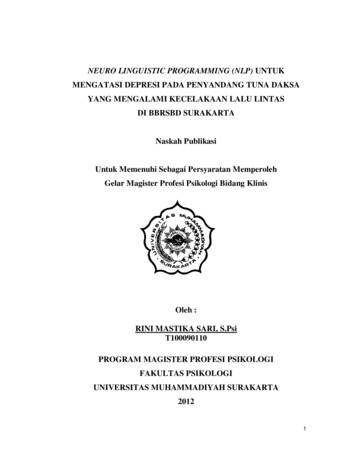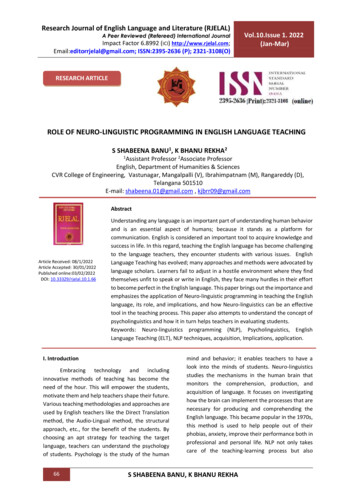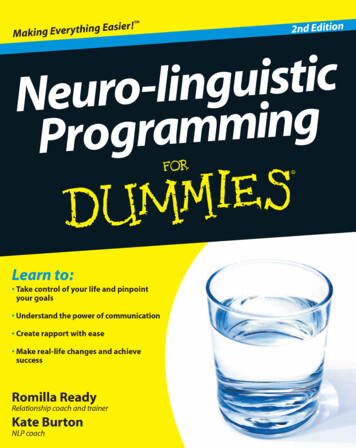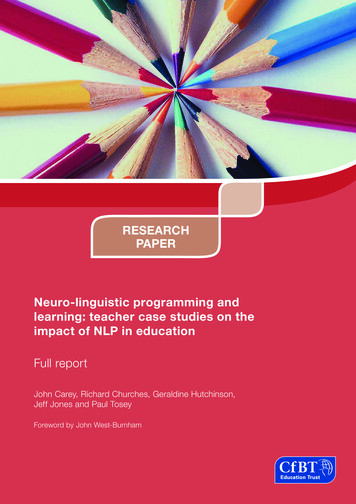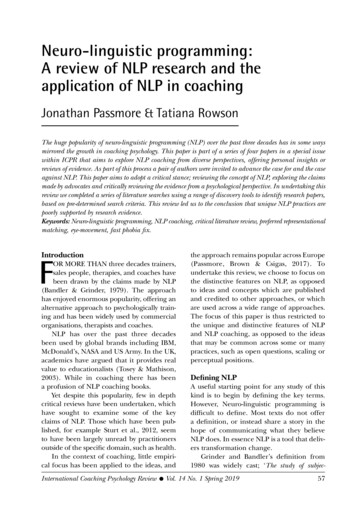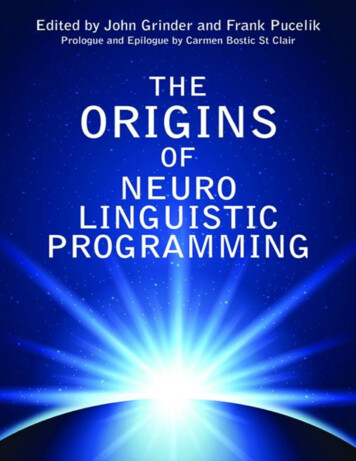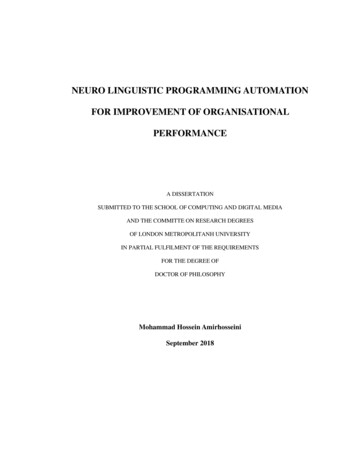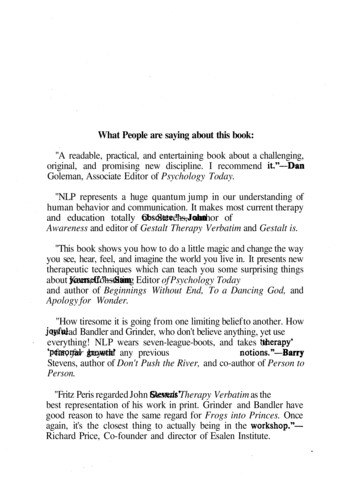
Transcription
What People are saying about this book:"A readable, practical, and entertaining book about a challenging,original, and promising new discipline. I recommend it."—DanGoleman, Associate Editor of Psychology Today."NLP represents a huge quantum jump in our understanding ofhuman behavior and communication. It makes most current therapyand education totally obsolete."—John O. Stevens, author ofAwareness and editor of Gestalt Therapy Verbatim and Gestalt is."This book shows you how to do a little magic and change the wayyou see, hear, feel, and imagine the world you live in. It presents newtherapeutic techniques which can teach you some surprising thingsabout yourself."—Sam Keen, Consulting Editor of Psychology Todayand author of Beginnings Without End, To a Dancing God, andApology for Wonder."How tiresome it is going from one limiting belief to another. Howjoyful to read Bandler and Grinder, who don't believe anything, yet useeverything! NLP wears seven-league-boots, and takes 'therapy' or'personal growth' far, far beyond any previous notions."—BarryStevens, author of Don't Push the River, and co-author of Person toPerson."Fritz Peris regarded John Stevens' Gestalt Therapy Verbatim as thebest representation of his work in print. Grinder and Bandler havegood reason to have the same regard for Frogs into Princes. Onceagain, it's the closest thing to actually being in the workshop."—Richard Price, Co-founder and director of Esalen Institute.
frogs into PRURCESReuro Linguistic ProgrammingbyRichard SandierandJohn Grinderedited bySteve ftndreas(formerly 3ohn Q. Stevens)TMREAL PEOPLE PRESS
Copyright 1979Real People PressBoxFMoab, Utah 84532ISBN: 0-911226-18-4 clothbound 11.00ISBN: 0-911226-19-2 paperbound 7.50Cover Artwork by Elizabeth Malczynski, Brooklyn, NYLibrary of Congress Cataloging in Publication Data:Sandier, Richard.Frogs into princes."Edited entirely from audiotapes of introductoryNLP training workshops conducted by Richard Bandlerand John Grinder."Bibliography: p.1. Psychotherapy. 2. Nonverbal communication.3. Psycholinguistics. 4. Imagery (Psychology)I. Grinder, John, joint author. II. Title.RC480.5.B313616.8'914, 79-13255ISBN 0-911226-18-4,;'.'ISBN 0-911226-19-2Other books about Neuro-Linguistic Programming from Real PeoplePress:USING YOUR BRAIN-FORA CHANGE, by Richard Bandler. 159pp. 1985 Cloth 11.00 Paper 7.50REFRAMING: Neuro-Linguistic Programming and the Transformation of Meaning, by Richard Bandler and John Grinder. 220 pp. 1981 Cloth 12.00 Paper 8.50TRANCE-FORMATIONS: Neuro-Linguistic Programming and the Structure ofHypnosis, by John Grinder and Richard Bandler. 250 pp. 1981 Cloth 12.00 Paper 8.50CHANGE YOUR MIND—AND KEEP THE CHANGE, by Steve Andreas andConnirae Andreas. 187 pp. 1987 Cloth 12.00 Paper 8.50The name Real People Press indicates our purpose; to publish ideas and ways that aperson can use independently or with others to become more real—lo further your owngrowth as a human being and to develop your relationship and communication withothers.8 9 10 Printing 93 92 91 90 89
ContentsForeword by Steve Andreas (formerly John O. Stevens)i-ivA Challenge to the ReaderI Sensory Experience:Representational Systems and Accessing Cues5-78II Changing Personal History and Organization:Anchoring79-136III Finding New Ways:RefrainingBibliography137-193194
ForewordI have been studying education, therapies, growth experiences, andother methods for personal change since I was a graduate student withAbe Maslow over twenty years ago. Ten years later I met Fritz Perisand immersed myself in gestalt therapy because it seemed to be moreeffective than most other methods. Actually all methods work for somepeople and with some problems. Most methods claim much more thanthey can deliver, and most theories have little relationship to themethods they describe.When I was first introduced to Neuro Linguistic Programming I wasboth fascinated and very skeptical. I had been heavily conditioned tobelieve that change is slow, and usually difficult and painful. I still havesome difficulty realizing that I can usually cure a phobia or othersimilar long-term problem painlessly in less than an hour—eventhough I have done it repeatedly and seen that the results last.Everything written in this book is explicit, and can be verified quicklym your own experience. There is no hocus-pocus, and you will not beasked to take on any new beliefs. You will only be asked to suspendyour own beliefs long enough to test the concepts and procedures ofNLP in your own sensory experience. That won't take long; most of thestatements and patterns in this book can be tested in a few minutes or afew hours. If you are skeptical, as I was, you owe it to your skepticismto check this out, and find out if the outrageous claims made in thisbook are valid.NLP is an explicit and powerful model of human experience andi
communication. Using the principles of NLP it is possible to describeany human activity in a detailed way that allows you to make manydeep and lasting changes quickly and easily.A few specific examples of things you can learn to accomplishare: (1) cure phobias and other unpleasant feeling responses in lessthan an hour, (2) help children and adults with "learning disabilities"(spelling and reading problems, etc.) overcome these limitations, oftenin less than an hour, (3) eliminate most unwanted habits—smoking,drinking, over-eating, insomnia, etc., in a few sessions, (4) makechanges in the interactions of couples, families and organizations sothat they function in ways that are more satisfying and productive, (5)cure many physical problems—not only most of those recognized as"psychosomatic" but also some that are not—in a few sessions.These are strong claims, and experienced NLP practitioners canback them up with solid, visible results. NLP in its present state can doa great deal, but it cannot do everything. if what weVe demonstrated is something that you'd like tobe able to do, you might as well spend your time learning it.There are lots and lots of things that we cannot do. If you canprogram yourself to look for things that will be useful'for youand learn those, instead of trying to find out where what we arepresenting to you falls apart, you?ll find out where it falls apart,I guarantee you. If you use it congruently you will find lots ofplaces that it won't work. And when it doesn't work, I suggestyou do something else.NLP is only about four years old, and many of the most usefulpatterns were created within the last year or two.We havent even begun to figure out what the possibilitiesare of how to use this material. And we are very, very, seriousabout that. What we are doing now is nothing more than theinvestigation of how to use this information. We have beenunable to exhaust the variety of ways to put this stuff togetherand put it to use, and we don't know of any limitations on theways that you can use this information. During this seminar wehave mentioned and demonstrated several dozen ways that itcan be used. It's the structure of experience. Period. When usedii
systematically, it constitutes a full strategy for getting anybehavioral gain.Actually, NLP can do much more than the kinds of remedial workentioned above. The same principles can be used to study people who" unusually talented in any way, in order to determine the structureof that talent. That structure can then be quickly taught to others togive them the foundation for that same ability. This kind ofintervention results in generative change, in which people learn togenerate and create new talents and behaviors for themselves andothers. A side effect of such generative change is that many of theproblem behaviors that would otherwise have been targets forremedial change simply disappear.In one sense nothing that NLP can accomplish is new: There havealways been "spontaneous remissions," "miracle cures," and othersudden and puzzling changes in people's behavior, and there havealways been people who somehow learned to use their abilities inexceptional ways.What is new in NLP is the ability to systematically analyze thoseexceptional people and experiences in such a way that they can becomewidely available to others. Milkmaids in England became immune tosmallpox long before Jenner discovered cowpox and vaccination; nowsmallpox—which used to kill hundreds of thousands annually—iseliminated from human experience. In the same way, NLP caneliminate many of the difficulties and hazards of living that we nowexperience, and make learning and behavioral change much easier,more productive, and more exciting. We are on the threshold of aquantum jump in human experience and capability.There is an old story of a boilermaker who was hired to fix a hugesteamship boiler system that was not working well. After listening tothe engineer's description of the problems and asking a few questions,he went to the boiler room. He looked at the maze of twisting pipes,listened to the thump of the boiler and the hiss of escaping steam for afew minutes, and felt some pipes with his hands. Then he hummedsoftly to himself, reached into his overalls and took out a smallhammer, and tapped a bright red valve, once. Immediately the entiresystem began working perfectly, and the boilermaker went home.When the steamship owner received a bill for 1,000 he complainedthat the boilermaker had only been in the engine room for fifteeniii
minutes, and requested an itemized bill. This is what the boilermakersent him:For tapping with hammer:For knowing where to tap:Total:.50 999.50 1,000.00What is really new in NLP is knowing exactly what to do, and how todo it. This is an exciting book, and an exciting time.Steve Andreas (formerly John O. Stevens)IV
A Challenge to the ReaderIn mystery and spy novels, the reader can expect to be offered aseries of written clues—fragmentary descriptions of earlier events.When these fragments are fitted together, they provide enough of arepresentation for the careful reader to reconstruct the earlier events,even to the point of understanding the specific actions and motivationsof the people involved—or at least to reach the understanding that theauthor will offer at the conclusion of the novel. The more casual readeris simply entertained and arrives at a more personal understanding, ofwhich s/ he may or may not be conscious. The writer of such a novel hasthe obligation to provide enough fragments to make a reconstructionpossible, but not obvious.This book is also the written record of a mystery story of sorts.However, it differs from the traditional mystery in several importantways. This is the written record of a story that was told, and storytelling is a different skill than story-writing. The story-teller has theobligation to use feedback from the listener/watcher to determine howmany clues s/he can offer. The kind of feedback s/he takes intoaccount is of two types: (1) the verbal, deliberate conscious feedback—those signals the listener/watcher is aware that s/he is offering to thestory-teller, and (2) the non-verbal, spontaneous, unconsciousfeedback: the glimpse, the startle, the labored recollection—thosesignals the listener/ watcher offers the story-teller without being awareof them. An important skill in the art of story-telling is to use theunconscious feedback so as to provide just enough clues that the
unconscious process of the listener/watcher arrives at the solutionbefore the listener/watcher consciously appreciates it. From suchartistry come the desirable experiences of surprise and delight—thediscovery that we know much more than we think we do.We delight in creating those kinds of experiences in our seminars.And while the record that follows may have contained enough clues forthe participant in the seminar, only the more astute reader will succeedin fully reconstructing the earlier events. As we state explicitly in thisbook, the verbal component is the least interesting and least influentialpart of communication. Yet this is the only kind of clue offered thereader here.The basic unit of analysis in face-to-face communication is thefeedback loop. For example, if you were given the task of describing aninteraction between a cat and a dog, you might make entries like: "Catspits, . dog bares teeth, . cat arches back,. dog barks,. cat—"At least as important as the particular actions described is the sequencein which they occur. And to some extent, any particular behavior bythe cat becomes understandable only in the context of the dog'sbehavior. If for some reason your observations were restricted to justthe cat, you would be challenged by the task of reconstructing what thecat was interacting with. The cat's behavior is much more difficult toappreciate and understand in isolation.We would like to reassure the reader that the non-sequiturs, thesurprising tangents, the unannounced shifts in content, mood ordirection which you will discover in this book had a compelling logic oftheir own in the original context. If these otherwise peculiar sequencesof communication were restored to their original context, that logicwould quickly emerge. Therefore, the challenge: Is the reader astuteenough to reconstruct that context, or shall he simply enjoy theexchange and arrive at a useful unconscious understanding of a morepersonal nature?John GrinderRichard Bandler
Sensory ExperienceThere are several important ways in which what we do differsradically from others who do workshops on communication orpsychotherapy. When we first started in the field, we would watchbrilliant people do interesting things and then afterwards they wouldtell various particular metaphors that they called theorizing. Theywould tell stories about millions of holes, or about plumbing: that youhave to understand that people are just a circle with pipes coming fromevery direction, and all you need is Draino or something like that.Most of those metaphors weren't very useful in helping people learnspecifically what to do or how to do it.Some people will do experiential workshops in which you will betreated to watching and listening to a person who is relativelycompetent in most, or at least part, of the business called "professionalcommunications." They will demonstrate by their behavior that theyare quite competent in doing certain kinds of things. If you arefortunate and you keep your sensory apparatus open, you will learnhow to do some of the things they do.There's also a group of people who are theoreticians. They will tellyou what their beliefs are about the true nature of humans and what thecompletely "transparent, adjusted, genuine, authentic," etc. personshould be, but they don't show you how to do anything.Most knowledge in the field of psychology is organized in ways thatttix together what we call "modeling"—what traditionally has beencalled "theorizing"—and what we consider theology. The descriptions5
of what people do have been mixed together with descriptions of whatreality "is." When you mix experience together with theories and wrapthem all up in a package, that's a psychotheology. What has developedin psychology is different religious belief systems with very powerfulevangelists working from all of these differing orientations.Another strange thing about psychology is that there's a whole bodyof people called "researchers" who will not associate with the peoplewho are practicing! Somehow the field of psychology got divided sothat the researchers no longer provide information for, and respond to,the clinical practitioners in the field. That's not true in the field ofmedicine. In medicine, the people doing research are trying to findthings to help the practitioners in the field. And the practitionersrespond to the researchers, telling them what they need to know moreabout.Another thing about therapists is that they come to therapy with aset of unconscious patternings that makes it highly probable that theywill fail. When therapists begin to do therapy they look for what'swrong in a content-oriented way. They want to know what the problemis so that they can help people find solutions. This is true whether theyhave been trained overtly or covertly, in academic institutions or inrooms with pillows on the floor.This is even true of those who consider themselves to be "processoriented." There's a little voice someiwhere in their mind that keepssaying "The process. Look for the process." They will say "Well, I'm aprocess-oriented therapist. I work with the process." Somehow theprocess has become an event—a thing in and of itself.There is another paradox in the field. The hugest majority oftherapists believe that the way to be a good therapist is to do everythingyou do intuitively, which means to have an unconscious mind that doesit for you. They wouldn't describe it that way because they don't likethe word "unconscious" but basically they do what they do withoutknowing how they do it. They do it by the "seat of their pants"—that'sanother way to say "unconscious mind." I think being able to do thingsunconsciously is useful; that's a good way to do things. The same groupof people, however, say that the ultimate goal of therapy is for peopleto have conscious understanding—insight into their own problems. Sotherapists are a group of people who do what they do without knowinghow it works, and at the same time believe that the way to really getsomewhere in life is to consciously know how things work!
7When I first got involved with modeling people in the field ofpsychotherapy, I would ask them what outcome they were workingtoward when they made a maneuver, when they reached over andtouched a person this way, or when they shifted their voice tone here.And their answer was "Oh, I have no idea." I'd say "Well, good. Areyou interested in exploring and finding out with me what the outcomewas?" And they would say "Definitely not!" They claimed that if theydid specific things to get specific outcomes that would be somethingbad, called "manipulating."We call ourselves modelers. What we essentially do is to pay verylittle attention to what people say they do and a great deal of attentionto what they do. And then we build ourselves a model of what they do.We are not psychologists, and we're also not theologians ortheoreticians. We have no idea about the "real" nature of things, andwe're not particularly interested in what's "true." The function ofmodeling is to arrive at descriptions which are useful. So, if we happento mention something that you know from a scientific study, or fromstatistics, is inaccurate, realize that a different level of experience isbeing offered you here. We're not offering you something that's true,just things that are useful.We know that our modeling has been successful when we cansystematically get the same behavioral outcome as the person we havemodeled. And when we can teach somebody else to be able to get thesame outcomes in a systematic way, that's an even stronger test.When I entered the field of communication, I went to a largeconference where there were six hundred and fifty people in anauditorium. And a man who was very famous got up and made thefollowing statement: "What all of you need to understand about doingtherapy and about communication is that the first essential step is tomake contact with the human you are communicating with as aperson." Well, that struck me as being kind of obvious. And everybodyin the audience went "Yeahhhh! Make contact. We all know about thatone." Now, he went on to talk for another six hours and nevermentioned how. He never mentioned one single specific thing thatanybody in that room could do that would help them in any way toeither have the experience of understanding that person better, or atleast give the other person the illusion that they were understood.I then went to something called "Active Listening." In activelistening you rephrase what everyone says, which means that you
8distort everything they say.Then we began to pay attention to what really divergent people whowere "wizards" actually do. When you watch and listen to VirginiaSatir and Milton Erickson do therapy, they apparently could not bemore different. At least I couldn't figure out a way that they couldappear more different.People also report that the experiences of being with them areprofoundly different. However, if you examine their behavior and theessential key patterns and sequences of what they do, they are similar.The patterns that they use to accomplish the rather dramatic thingsthat they are able to accomplish are very similar in our way ofunderstanding. What they accomplish is the same. But the way it'spackaged—the way they come across—is profoundly different.The same was true of Fritz Peris. He was not quite as sophisticatedas Satir and Erickson in the number of patterns he used. But when hewas operating in what I consider a powerful and effective way, he wasusing the same sequences of patterns that you will find in their work.Fritz typically did not go after specific outcomes. If somebody came inand said "I have hysterical paralysis of the left leg," he wouldn't go afterit directly. Sometimes he would get it and sometimes he wouldn't. BothMilton and Virginia have a tendency to go straight for producingspecific outcomes, something I really respect.When I wanted to learn to do therapy, I went to a month-long workshop, a situation where you are locked up on an island and exposedevery day to the same kinds of experiences and hope that somehowor other you will pick them up. The leader had lots and lots of experience, and he could do things that none of us could do. But when hetalked about the things he did, people there wouldn't be able to learnto do them. Intuitively, or what we describe as unconsciously, hisbehavior was systematic, but he didn't have a conscious understanding of how it was systematic. That is a compliment to his flexibility andability to discern what works.For example, you all know very, very little about how you are able togenerate language. Somehow or other as you speak you are able tocreate complex pieces of syntax, and I know that you don't make anyconscious decisions. You don't go "Well, I'm going to speak, and firstI'll put a noun in the sentence, then I'll throw an adjective in, then averb, and maybe a little adverb at the end, you know, just to color it upa little bit." Yet you speak a language that has grammar and syntax—
9rules that are as mathematical and as explicit as any calculus. There's agroup of people called transformational linguists who have managedto take large amounts of tax dollars and academic space and figure outwhat those rules are. They haven't figured out anything to do with thatyet, but transformational grammarians are unconcerned with that.They are not interested in the real world, and having lived in it I cansometimes understand why.When it comes to language, we're all wired the same. Humans havepretty much the same intuitions about the same kinds of phenomena inlots and lots of different languages. If I say "You that look understandidea can," you have a very different intuition than if I say "Look, youcan understand that idea," even though the words are the same. There'sa part of you at the unconscious level that tells you that one of thosesentences is well-formed in a way that the other is not. Our job asmodelers is to do a similar task for other things that are more practical.Our job is to figure out what it is that effective therapists do intuitivelyor unconsciously, and to make up some rules that can be taught tosomeone else.Now, what typically happens when you go to a seminar is that theleader will say "All you really need to do, in order to do what I do as agreat communicator, is to pay attention to your guts." And that's true,//you happen to have the things in your guts that that leader does. Myguess is you probably don't. You can have them there at theunconscious level, but I think that if you want to have the sameintuitions as somebody like Erickson or Satir or Peris, you need to gothrough a training period to learn to have similar intuitions. Once yougo through a conscious training period, you can have therapeuticintuitions that are as unconscious and systematic as your intuitionsabout language.If you watch and listen to Virginia Satir work you are confrontedwith an overwhelming mass of information—the way she moves, hervoice tone, the way she touches, who she turns to next, what sensorycues she is using to orient herself to which member of the family, etc.It's a really overwhelming task to attempt to keep track of all the thingsthat she is using as cues, the responses that she is making to those cues,and the responses she elicits from others.Now, we don't know what Virginia Satir really does with families.However, we can describe her behavior in such a way that we can cometo any one of you and say "Here. Take this. Do these things in this
10sequence. Practice until it becomes a systematic part of yourunconscious behavior, and you will end up being able to elicit the sameresponses that Virginia elicits." We do not test the description we arriveat for accuracy, or how it fits with neurological data, or statistics aboutwhat should be going on. All we do in order to understand whether ourdescription is an adequate model for what we are doing is to find outwhether it works or not: are you able to exhibit effectively in yourbehavior the same patterns that Virginia exhibits in hers, and get thesame results? We will be making statements up here which may have norelationship to the "truth," to what's "really going on." We do know,however, that the model that we have made up of her behavior has beeneffective. After being exposed to it and practicing the patterns and thedescriptions that we have offered, people's behavior changes in waysthat make them effective in the same way that Satir is, yet eachperson's style is unique. If you learn to speak French, you will stillexpress yourself in your own way.You can use your consciousness to decide to gain a certain skillwhich you think would be useful in the context of your professionaland personal work. Using our models you can practice that skill.Having practiced that consciously for some period of time you canallow that skill to function unconsciously. You all had to consciouslypractice all the skills involved in driving a car. Now you can drive along distance and not be conscious df any of it, unless there's someunique situation that requires your attention.One of the systematic things that Erickson and Satir and a lot ofother effective therapists do is to notice unconsciously how the personthey are talking to thinks, and make use of that information in lots andlots of different ways. For example, if I'm a client of Virginia's I mightgo:"Well, man, Virginia, you know I just ah . boy! Thingshave been, they've been heavy, you know. Just, you know, mywife was. my wife was run over by a snail and. you know,I've got four kids and two of them are gangsters and I thinkmaybe I did something wrong but I just can't get a grasp onwhat it was,"I don't know if you've ever had the opportunity to watch Virginiaoperate, but she operates very, very nicely. What she does is very
11magical, even though I believe that magic has a structure and isavailable to all of you. One of the things that she would do in herresponse would be to join this client in his model of the world byresponding in somewhat the following way:"I understand that you feel certain weight upon you, andthese kinds of feelings that you have in your body aren't whatyou want for yourself as a human being. You have differentkinds of hopes for this."It doesn't really matter what she says, as long as she uses the samekinds of words and tonal patterns. If the same client were to go toanother therapist, the dialogue might go like this:"Well, you know, things feel real heavy in my life, Dr. Handler. Youknow, it's just like I cant handle it, you know .""I can see that, Mr. Grinder.""I feel like I did something wrong with my children and I don't knowwhat it is. And I thought maybe you could help me grasp it, youknow?""Sure. I see what it is you're talking about. Let's focus in on oneparticular dimension. Try to give me your particular perspective. Tellme how it is that you see your situation right now.""Well, you know, I just. I'm. I just feel like I cant get a graspon reality.""I can see that. What's important to me—colorful as yourdescription is—what's important to me is that we see eye to eye aboutwhere it is down the road that we shall travel together.""I'm trying to tell you that my life has got a lot of rough edges, youknow. And I'm trying to find a way.""It looks all broken up from. from your description, at any rate.The colors aren't all that nice."While you sit here and laugh, we can't even get as exaggerated aswhat we've heard in "real life." We spent a lot of time going around tomental health clinics and sitting in on professional communicators. It'svery depressing. And what we noticed is that many therapistsmismatch in the same way that we just demonstrated.We come from California and the whole world out there is run by
12electronics firms. We have a lot of people who are called "engineers,"and engineers typically at a certain point have to go to therapy. It's arule, I don't know why, but they come in and they usually all say thesame thing, they go:"Well, I could see for a long time how, you know, I was reallyclimbing up and becoming successful and then suddenly, you know,when I began to get towards the top, I just looked around and my lifelooked empty. Can you see that? I mean, could you see what that wouldbe like for a man of my age?""Well, I'm beginning to get a sense of grasping the essence of thekinds of feelings that you have that you want to change.""Just a minute, because what I want to do is I'm trying to show youmy perspective on the who
Other books about Neuro-Linguistic Programming from Real People Press: USING YOUR BRAIN-FORA CHANGE, by Richard Bandler. 159pp. 1985 Cloth 11.00 Paper 7.50 REFRAMING: Neuro-Linguistic Programming and the Transformation of Mean-ing, by Richard Bandler and John Grinder. 220 pp. 1981 Cloth 12.00 Paper 8.50
